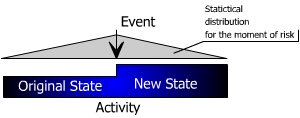Moment of risk and state of activity
An activity (task) in most real life processes is not a continuous uniform procedure. Tasks are affected by external events, which transform an activity from one state to another. Events have a number of properties. Among them are:
- event identification (name);
- probability of occurrence;
- type (e.g. cancel task, increase/reduce duration/cost, move resource to another start, change probability of other risk, start activity, execute mitigation plan);
- and, impact (e.g. an increase of duration by 10%).
One of the important properties of an event is the moment when an event occurs during the course of an activity. This moment, when an event occurs, in most cases is probabilistic and can be defined using statistical distribution. In the example, the moment of risk is defined by a triangular statistical distribution:

The most likely moment of occurrence will be at the middle of the activity. Event occurs during the course of activity. Moment of risk is important because of two main reasons:
- Very often, the risk impact depends on when a risk occurs, as the moment of risk can affect, for example, whether an activity will be restarted or cancelled.
- Probabilistic moment of risk is important for adjusting the duration or cost of an activity due to actual performance.
The notion of state is very important as states can serve as a precondition for other events: some risks may or may not occur or if the activity is in certain state.
Events can have a negative (risks) or positive (opportunities) impact on the project.




